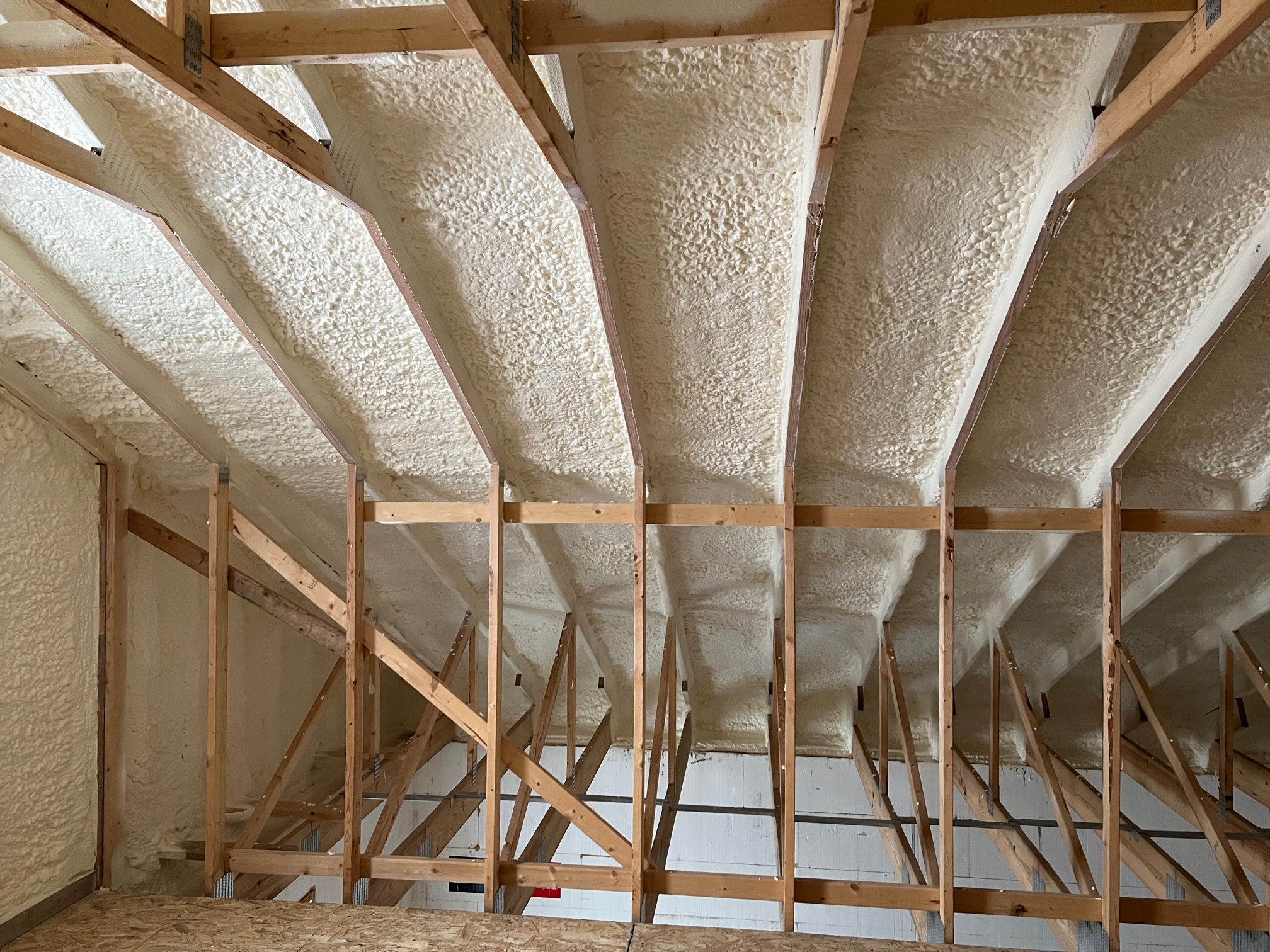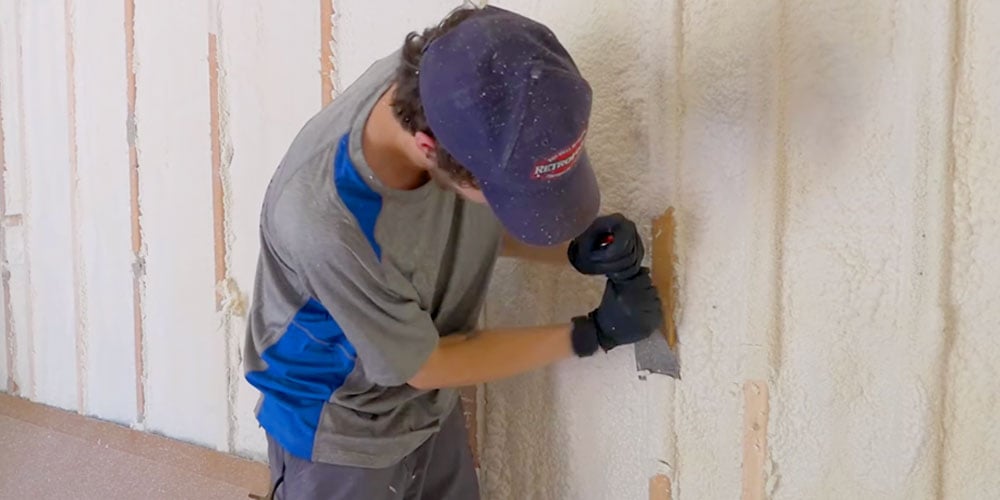How Spray Foam Can Improve Power Efficiency in Your Home
How Spray Foam Can Improve Power Efficiency in Your Home
Blog Article
Spray Foam: The Ultimate Service for Air Sealing and Insulation
Spray foam insulation has actually arised as a leading service for effective air securing and thermal insulation, using a distinct combination of residential or commercial properties that establish it apart from traditional techniques. Comprehending the full range of its benefits, installation processes, and comparisons with various other insulation kinds is crucial for making educated decisions.
What Is Spray Foam?
Spray foam is a versatile insulation material that combines the principles of air sealing and thermal resistance to enhance power effectiveness in structures. Composed largely of polyurethane or other comparable compounds, spray foam is applied as a fluid that broadens upon contact with surfaces, developing a strong, constant layer of insulation. This distinct residential property permits it to load gaps, cracks, and spaces that standard insulation materials may ignore, providing a remarkable air seal.
There are two major kinds of spray foam: open-cell and closed-cell. Open-cell spray foam is lighter and more flexible, providing excellent sound absorption and a lower R-value per inch - Spray Foam. On the other hand, closed-cell spray foam is denser, offering a greater R-value, moisture resistance, and added structural integrity to developing components
The application procedure generally entails specialized devices, ensuring a seamless application that sticks to numerous substrates, consisting of concrete, wood, and metal. This versatility makes spray foam ideal for both brand-new constructions and retrofitting existing structures. Its capability to develop a closed obstacle substantially adds to decreasing power consumption and enhancing indoor air quality, thereby making it a preferred selection among builders and property owners alike.
Advantages of Spray Foam Insulation
Among the most considerable advantages of spray foam insulation is its remarkable capacity to create a continuous air barrier, which efficiently minimizes power loss. Unlike conventional insulation products, spray foam increases to fill splits and spaces, making sure that air leakage is substantially minimized. This particular not only boosts energy effectiveness yet additionally causes decrease utility expenses over time.
Furthermore, spray foam insulation gives premium thermal resistance, contributing to a more steady interior environment. Its high R-value per inch enables effective insulation in restricted spaces, making it excellent for attic rooms, walls, and crawl areas. The moisture-resistant residential or commercial properties of spray foam help avoid mold and mildew growth, promoting healthier living conditions.
An additional crucial advantage of spray foam insulation is its sound-dampening top qualities (Spray Foam). It successfully minimizes noise transmission in between spaces, producing a quieter and extra comfy home atmosphere. The toughness of spray foam likewise stands out, as it does not droop or resolve over time, maintaining its efficiency throughout its life expectancy
How Spray Foam Functions
Comprehending exactly how spray foam insulation functions is important for appreciating its performance in air sealing and thermal resistance. Spray foam insulation includes 2 key elements: isocyanate and polyol resin. When these components are blended, they undergo a chemical response that causes the product to broaden swiftly, creating a dense foam that loads gaps, company website splits, and dental caries.
As the foam broadens, it abides by surface areas, forming an airtight seal that substantially reduces air seepage. This characteristic makes spray foam insulation extremely reliable at stopping drafts and wetness infiltration, which can lead to energy loss and damage over time. Additionally, the closed-cell variant of spray foam provides exceptional thermal resistance due to its rigid framework, effectively lessening warm transfer.
The distinct residential or commercial properties of spray foam permit it to adapt to uneven surfaces, making certain thorough protection and a seamless obstacle. Because of this, spray foam insulation not only enhances energy effectiveness however also adds to improved indoor air high quality by reducing the build-up of irritants and contaminants. Eventually, recognizing the mechanics behind spray foam underscores its role as a premium option for insulation and air sealing in both industrial and domestic applications.
Installment Process Overview

Before installment, the space needs to be adequately cleaned up and prepped, making certain that surface areas are complimentary from dirt, moisture, and particles. Since pollutants can compromise attachment and general efficiency, this step is essential. When the area is prepared, the application involves blending the two elements of the spray foam, which broadens upon contact and fills up voids efficiently.
Educated professionals must carry out the installment, making use of customized equipment to ensure uniform insurance coverage and ideal density. Security safety measures, including putting on protective equipment and guaranteeing proper ventilation, are important throughout this process. After application, the foam normally treatments promptly, creating a solid obstacle that boosts energy my latest blog post efficiency.
Comparing Spray Foam to Traditional Insulation
When evaluating insulation choices, spray foam insulation attracts attention in contrast to traditional materials such as fiberglass and cellulose. Among the primary advantages of spray foam is its superior air securing abilities. Unlike fiberglass and cellulose, which can enable air seepage, spray foam expands upon application, loading holes and spaces to create a closed seal. This results in boosted energy effectiveness, as less heated or cooled air gets away the home, leading to reduced energy costs.
In addition, spray foam provides a higher R-value per inch than conventional insulation types, using even more effective thermal resistance in a thinner profile. This characteristic is particularly beneficial precede with minimal dental caries depth. Additionally, spray foam is immune to moisture and mold and mildew growth, which can be a substantial interest in cellulose and fiberglass, specifically in moist settings.
However, spray foam insulation usually carries a higher in advance cost than its traditional counterparts. Property owners need to weigh this initial financial investment versus lasting power savings and performance benefits. Eventually, while both insulation types serve their function, spray foam emerges as an advanced solution for modern-day insulation needs, particularly in regards to air sealing and thermal effectiveness.

Conclusion
In recap, spray foam insulation stands for a highly reliable service for attaining optimum air sealing and thermal resistance. Its special residential or commercial properties, including dampness resistance and audio dampening, make it appropriate for various applications in both new constructions and retrofitting projects (Spray Foam). The preliminary prices might be higher contrasted to standard insulation products, the long-term advantages, such as considerable energy cost savings and enhanced interior air quality, validate the financial investment and highlight its worth in modern-day structure methods.
Spray foam insulation has emerged as a leading remedy for efficient air sealing and thermal insulation, supplying an one-of-a-kind mix of buildings that establish it apart from conventional approaches.Spray foam is a flexible insulation material that incorporates the concepts of air securing and thermal resistance to enhance power performance in structures.When assessing insulation alternatives, spray foam insulation stands out in comparison to traditional materials such as fiberglass and cellulose. Inevitably, while both insulation types serve their function, spray foam emerges as a more innovative solution for modern-day insulation demands, especially in terms of air sealing and thermal effectiveness.
In recap, spray foam insulation represents a highly effective solution for accomplishing optimum air sealing and thermal resistance.
Report this page